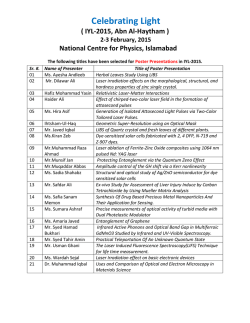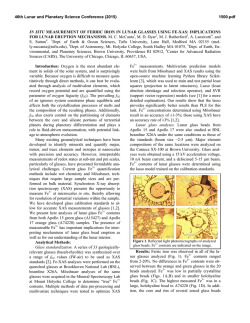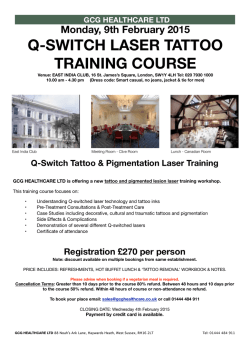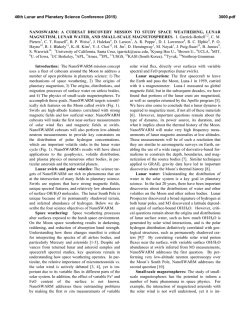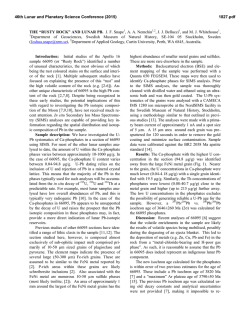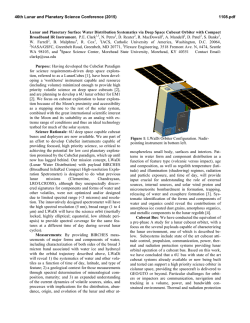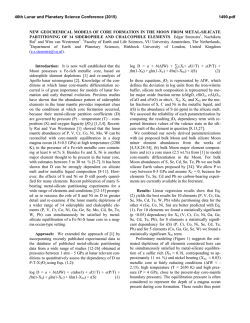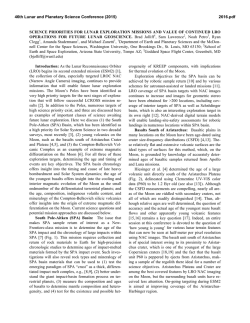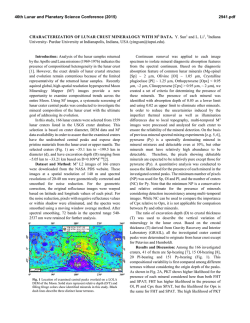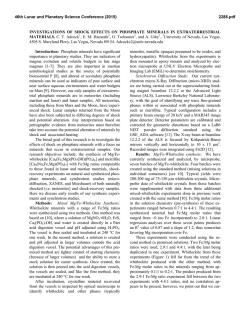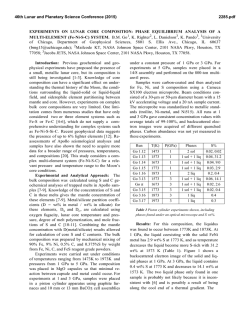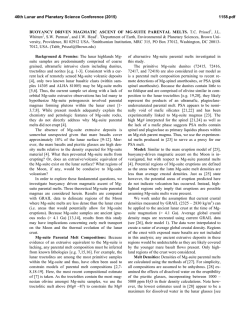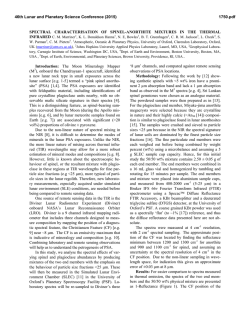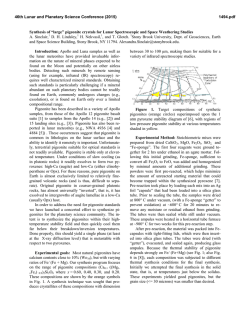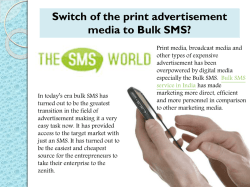
3D-LASER-SCANNING TECHNIQUE APPLIED TO - USRA
46th Lunar and Planetary Science Conference (2015) 1716.pdf 3D-LASER-SCANNING TECHNIQUE APPLIED TO BULK DENSITY MEASUREMENTS OF APOLLO LUNAR SAMPLES. R. J. Macke, S.J.1,2, J. J. Kent3, W. S. Kiefer4, and D. T. Britt5,2, 1Vatican Observatory V00120 Vatican City State [email protected], 2Center for Lunar and Asteroid Surface Science, Orlando FL, 3Jacobs Technology, Inc., Houston TX, 4Lunar and Planetary Institute, Houston TX, 5University of Central Florida, Orlando FL. Introduction: In order to better ty of 24,800 points cm-2 and a texinterpret gravimetric data from orbitture density of 62 dots cm-2. ers such as GRAIL and LRO to unDuring measurement, the sample derstand the subsurface composition is placed on the rotating stage. 10 to and structure of the lunar crust, it is 16 separate scans are produced with import to have a reliable database of the stage rotated partially between the density and porosity of lunar each scan, producing a 360-degree materials. To this end, we have been partial model of the sides of the surveying these physical properties sample. To fill in the missing top in both lunar meteorites and Apollo and bottom portions, the sample is lunar samples. tilted and the scan is repeated. The To measure porosity, both grain entire process can take from 30 density and bulk density are reminutes for a low-resolution scan quired. For bulk density, our group (suitable for larger samples with has historically utilized sub-mm bead regular surfaces) to 90 minutes at immersion techniques extensively high resolution (better for irregular [cf. 1,2], though several factors have surfaces or small samples). made this technique problematic for Figure 1: Laser scanner apparatus Following measurement, the parour work with Apollo samples. tial models must be processed to Samples allocated for measurement are often smaller remove artifacts and then merged to form a complete than optimal for the technique, leading to large error shape model, from which volume is calculated. This bars. Also, for some samples we were required to use generally takes less than an hour, but may be done pure alumina beads instead of our usual glass beads. after-the-fact. Thus, it need not interfere with producThe alumina beads were subject to undesirable static tivity during the scanning process itself. effects, producing unreliable results [3]. We found that the software had difficulty meshing Other investigators have tested the use of 3d laser scans of samples that had been cut into regular shapes scanners on meteorites for measuring bulk volumes such as cubes or parallelepipeds, producing a chaotic [cf. 4]. Early work, though promising, was plagued mess. Including external references in the scan window with difficulties including poor response on dark or eliminated this problem, and since adopting this pracreflective surfaces, difficulty reproducing sharp edges, tice we have encountered no further difficulties. and large processing time for producing shape models. Theoretical 1-σ uncertainties in volumetric measDue to progress in technology, however, laser scanners urements at high resolution are about 0.4% for a 1 cm3 have improved considerably in recent years. sample and decrease with sample size to 0.02% for We tested this technique on 27 lunar samples in the samples above about 40 cm3. We are still trying to Apollo collection using a scanner at NASA Johnson confirm this experimentally, but the device appears to Space Center. We found it to be reliable and more be capable of at least an order of magnitude improveprecise than beads, with the added benefit that it inment over the Archimedean glass bead method. volves no direct contact with the sample, enabling the The scanner was tested using an arbitrary sample of study of particularly friable samples for which bead low-grade high-carbon ferro-manganese alloy that reimmersion is not possible. sembled a meteorite in its exterior. This object’s low Instrumentation and measurement: We utilized albedo and irregular shape with a specular feature a NextEngine 3D Scanner HD model 2020i located onwould have been challenging for early laser scanners. site at NASA Johnson Space Center. This instrument It was scanned at three resolutions. High and medium was supplemented by ScanStudio HD Pro and the resolution results agreed to within 0.001% at 21.1223 CAD Tools software. The scanner also comes with a cm3 and 21.1219 cm3, respectively Low-resolution rotating stage. Documentation for the scanner claims produced 21.1052 cm3, or a difference of 0.08% from dimensional accuracy of 0.1 mm, with a capture densithe other scans. 46th Lunar and Planetary Science Conference (2015) Results: We completed scans of 27 lunar samples over the course of 7 workdays in October. Many of these had been previously measured with alumina beads. While most of the alumina-bead results are within 2σ of the laser results, many fall outside that margin, with lower-mass samples having the greatest errors (Fig. 2). We attribute this to the unreliability of the bead technique for samples less than about 10 gm, coupled with the strong static response of the alumina beads. Figure 2: Difference between bulk densities measured with alumina beads vs. with laser, as a function of sample mass. Error bars are 1-σ based on bead data. Figure 3: Bulk densities of all lunar samples (including meteorites) measured to date. Blue dots are glass-bead data, and red dots are laser data. Groups are: (1) Imbrium ejecta, (2) feldspathic, (3) impact-melt breccia, (4) other (regolith or polymict) breccia, (5) low-Ti basalt, (6) high-Ti basalt. 1716.pdf Figure 4: 14305,483 (wrapped in aluminum foil) in the larger pycnometer. When compared with lunar samples and meteorites that had been measured with glass beads, there is good agreement in the data between the laser and the bead results for rocks of the same type (Fig. 3). Because only one glass-bead-measured sample was subsequently scanned (and it was only 4.5 gm), variation in results cannot a priori be attributed to either inhomogeneity among samples or measurement accuracy. 14305,483: A 156 gm slab of 14305, normally a display piece, was temporarily available for measurement. This piece of Imbrium ejecta from Fra Mauro was too large to fit in our bead container or our idealgas pycnometer (used for grain densities). This made it a good testbed for two new instruments: the laser scanner and a new larger pycnometer [5] (Fig. 4). Both instruments proved quite suitable for a sample of this size yielding a bulk density of 2.45 g cm-3, a grain density of 3.10 g cm-3, and a porosity of 21%. Friable samples: The laser enabled measurement of several samples that due to friability had been excluded from use with beads. Among these was 14321,88, a 76 gm piece from the Fra Mauro formation which, along with 14305, helps constrain its properties. The two samples are in strong agreement in bulk and grain densities as well as porosities. Ongoing work: We expect that 3D laser scanning is soon to replace the glass-bead method as the standard technique for bulk volume measurements. We have acquired an instrument for the Vatican Observatory, and are in the process of scanning much of the Vatican meteorite collection, focusing on those samples that had been too friable or fragile for bead work. References: [1] Macke R. J. et al. (2011) Meteorit. Planet. Sci. 46, 311-326. [2] Kiefer W. S. et al. (2012) Geophys. Res. Lett. 39, L07201. [3] Macke R. J. et al. (2014) LPSC XLV, abstract #1949. [4] McCausland P. J. A. et al. (2007) Meteorit. Planet. Sci. Suppl. 42, A5066. [5] Macke R. J. et al. (2013) LPSC XLIV, abstract #1398.
© Copyright 2026

